List of facial hairstyles
This is a list of facial hairstyles.
| Name | Image | Description |
|---|---|---|
| Balbo |  Italian Air Marshall Italo Balbo |
An extended version of the Van Dyke which wraps around the mouth, with the ends of the moustache (and sometimes also the jawline) flared out beyond the lines that connect to the chin. Named for Italian Marshal of the Air Force Italo Balbo. This style was common among 19th- and early 20th-century German collegiates and military officials. |
| Beard | 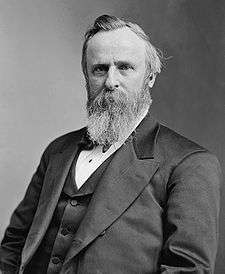 19th President of the United States Rutherford B. Hayes, sporting a full beard |
The simple term "beard" is an umbrella term which can include any style of facial hair, although generally excluding a moustache by itself.
A "full beard" is one which shows full, unmodified growth on all available areas of the face and neck, including the moustache, chin, sideburns, and cheeks. |
| Chin curtain | 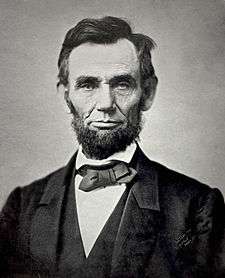 16th President of the United States Abraham Lincoln |
A full beard without a mustache or neck hair. |
| Chinstrap beard | 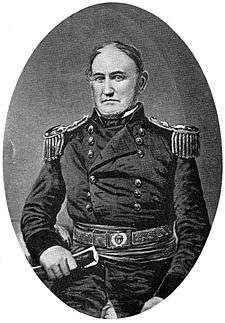 American Civil War general David E. Twiggs |
Sideburns which are connected to each other by a narrow line of hair along the jaw, resembling a helmet strap harnessed to one's chin. |
| Clean shaven | 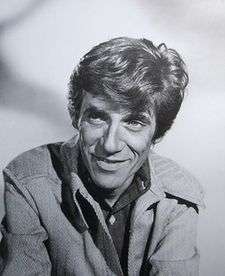 American actor William Hickey |
A clean shaven facial hairstyle contains no facial hair at all other than eyebrows and short, neatly trimmed sideburns. As the name suggests, the face is cleanly shaven. To remain clean shaven, daily shaving is often required. |
| Friendly muttonchops | 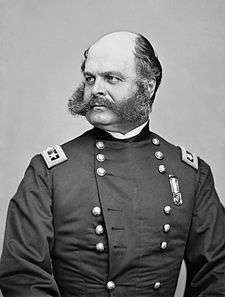 American Civil War general Ambrose Burnside |
Muttonchops which are connected by a moustache, but no chin hair (which would make it a full beard).[1] |
| Fu Manchu | 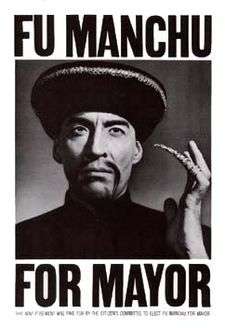 Eponymous fictional villain Dr. Fu Manchu |
A thin, narrow, mustache that grows downward in two very long tendrils from the upper lip, with the tapered, pointed ends hanging past the jawline. Named after a fictional Chinese villain (Dr. Fu Manchu) whose portrayal in print and film media invented the style. It is similar to the horseshoe moustache, but differentiated by the chin and cheeks area being smooth shaven with the lip tendrils overhanging them. |
| Goat patch | 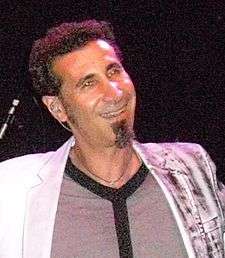 Armenian-American heavy metal musician Serj Tankian |
Facial hair growing only from the chin directly beneath the mouth. This is meant to resemble the hair on the chin of a goat. Also called a "chin puff" or "chin strip." |
| Goatee |  Abraham Lincoln |
A beard style incorporating hair on the chin but not the cheeks. Traditionally, the term referred to a style including only the hair on the lower jaw around the mouth, but has become a blanket term to refer to any style incorporating hair on the chin but not the cheeks, including those with incorporated mustaches. |
| Goatee and moustache |  A generic goatee and moustache |
A goatee in which the mustache is allowed to connect to the hair on the chin. Also referred to as a circle beard or Van Dyke.[2] Since the 1990s, the style has become synonymous with "goatee". |
| Handlebar moustache | 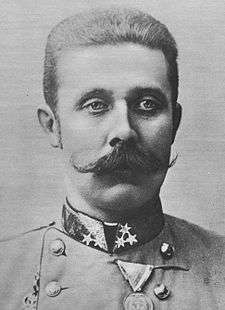 |
A moustache which has its ends grown much longer and often flared out. This is usually accentuated by styling the hair with a product such as hair gel or moustache wax. Occasionally, the ends are worn in loops. |
| Horseshoe moustache |  |
A full mustache with ends that extend down in parallel straight lines beyond the upper lip and down to the jawline. It is similar to the traditional goatee, except for the clean-shaven chin, and resembles a horseshoe or an inverted U. |
| Moustache | 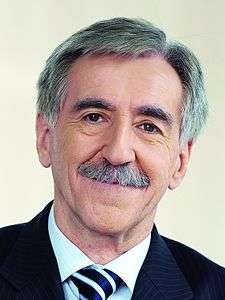 |
A moustache is defined as any facial hair grown specifically on the upper lip. There are many different types of moustache, but all differentiate between hair grown exclusively on the upper lip and hair grown on other parts of the face (which would make the facial hair a beard). |
| Mutton chops |  |
A more elaborate growth of sideburns which also grow larger toward the chin, resembling a mutton chop (cut of meat with a bone sticking out). Originated with American Civil War general Ambrose Burnside, whose unusually large muttonchops (with a connected mustache-- see "Friendly Muttonchops") set the standard for later comparisons. |
| Neckbeard | 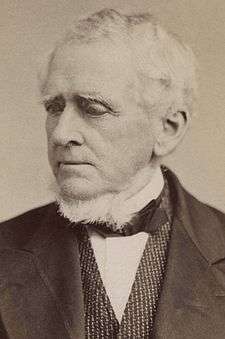 |
A beard which does not include any hair on the face, but includes the hair of the neck, or under the jaw, or both. |
| Pencil moustache | |
A Pencil Moustache is one which is very thin, usually just above the line of the upper lip. It is supposed to look narrow enough to have been drawn on with a pencil (or eyeliner). Often a man wearing a Pencil Moustache will shave the area above it to accentuate the remaining hair. |
| Shenandoah | 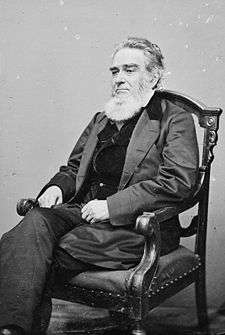 |
A fuller version of the chin curtain in which only the mustache is shaved, allowing the hair on the neck to grow out. The Shenandoah style was common in the 19th century in Europe and North America, and is often associated with the Amish community. |
| Sideburns | 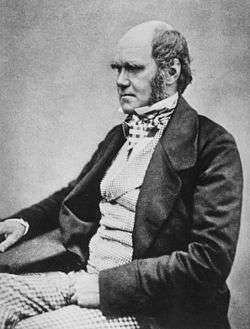 |
Originally known as "Burnsides", sideburns are the patch of hair in front of the ears which connects a beard to the hair of one's head. Any extension beyond a simple corner angle on the front side of the head is considered to be a sideburn, though they can range widely in size from short and neatly cropped to the distinctly massive "muttonchops" of Ambrose Burnside (who gave the term its original name). |
| Sidewhiskers | |
Related to sideburns and muttonchops, but considerably more extreme. Classic sidewhiskers hang well below the jawline. They may be connected via a moustache, as in this picture of Chester A. Arthur, but this is not always the case (similar to the situation with standard and friendly mutton chops). |
| Soul patch | 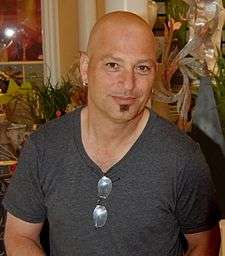 |
The Soul Patch is the area just below the lower lip, not including the hair over the chin. This style of beard is often grown narrow and sometimes made into a spike. The stereotypical image of a 1960s Beatnik often includes a soul patch. |
| Stubble (also called Five-o'Clock Shadow) |  |
Stubble is any length of hair (anywhere) which is long enough to be seen, but short enough to not fully cover the skin beneath. This contributes to an image that a man is anywhere between relaxed and casual to disheveled and unclean.
The term Five-o'Clock Shadow refers to stubble which is very short, apparently only a few hours' growth (as it would look at 5 PM after a man shaved that morning). |
| Toothbrush moustache | |
This is a narrow but tall moustache which generally does not extend beyond the sides of the nose, and extends the full height of the upper lip. This type of facial hair very much resembles a small brush like a toothbrush. Charlie Chaplin was the first famous wearer, and his popularity made the toothbrush style fashionable worldwide in the early 20th century. However, Adolf Hitler's adoption of a toothbrush mustache from 1919 onward eventually led to a distinct association between the style and the German Nazi leader. Resultantly re-dubbed the "Hitler moustache" in the public consciousness, the toothbrush style became instantly unpopular after 1939 and nearly extinct after World War II. |
| Van Dyke beard |  |
The Van Dyke style is a type of goatee in which the chin hair is disconnected from the moustache hair. Often the two patches are shaped and styled independently of each other, sometimes with the chin being made into a narrow oval shape and the moustache flared out like a Handlebar style. This style is sometimes called a "French Beard" due to its widespread popularity in French culture of the late 19th and early 20th centuries. |
| Walrus moustache | 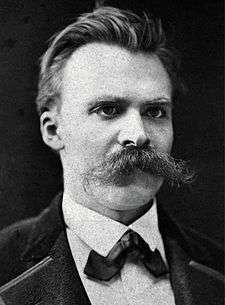 |
The walrus moustache is characterized by whiskers that are thick, bushy, and droop over the mouth. The style resembles the whiskers of a walrus, hence the name. |
| The Zappa[2] | .jpg) |
The Zappa style consists of a wide soul patch and full moustache that extends slightly downward past the corners of the mouth. Named for American musician Frank Zappa. |
See also
References
External links
This article is issued from Wikipedia - version of the 11/15/2016. The text is available under the Creative Commons Attribution/Share Alike but additional terms may apply for the media files.